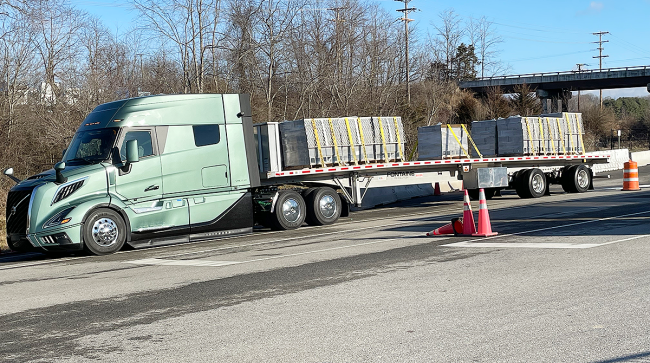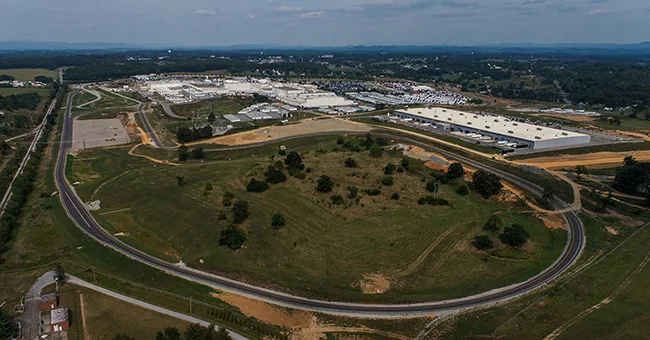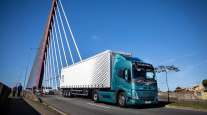Executive Editor
Volvo Offers Early Look at Redesigned VNL

[Stay on top of transportation news: Get TTNews in your inbox.]
DUBLIN, Va. — Volvo Trucks North America offered media a sneak preview of its redesigned VNL Class 8 tractor during a ride-and-drive event at its customer center, providing firsthand experience with the truck’s proprietary active safety system, updated automated transmission, and other customer-focused factors that VTNA said steered the truck’s design.
That includes a slate of aerodynamic and powertrain-related updates that the manufacturer said delivers a 10% overall fuel economy gain inclusive of powertrain and aerodynamic improvements compared with the outgoing model.
Developed by and for the North American market, VTNA executives stressed that the truck’s clean-sheet redesign will provide the basis for new products to come — including battery-electric, fuel cell electric, and hydrogen internal combustion engines running on renewable fuels.
“We are investing more than we ever have before in research and development,” said Magnus Koeck, vice president of marketing, strategy and brand management for VTNA, during the Feb. 13 event, where two preproduction models were made available for media. The redesign resulted in a truck where 90% of the components are different from the outgoing model.
The new @VolvoTrucksNA VNL offers a 10% overall fuel efficiency improvement over its predecessor, and features the company’s new proprietary driver assist safety system. @TransportTopics is driving pre-production versions today. pic.twitter.com/8fvVsJ0kc7 — Joe Howard (@JoeHoward_TT) February 13, 2024
“It’s not every day we do that,” Koeck said. “It’s the end of an era, but the start of a new era.”
The first VN-series truck was introduced in 1996.
Changes to the new truck include improved shifting intervals for the truck’s I-Shift automated transmission, updates to the D13 engine’s architecture, and a 24-volt battery management system that Volvo said reduces battery failure rates, speeds diagnostics abilities, and allows for an all-electric cooling system that replaces a diesel-powered auxiliary power unit.

Magnus Koeck speaks at the Feb. 13 event. (Joe Howard/Transport Topics)
From behind the wheel, forward visibility was good through the VNL’s curved, panoramic windshield, and the truck’s wedge-shaped cab offers improved aerodynamic performance from its predecessor, company executives said. Product marketing manager Bobby Compton said the hood’s curvature and low ground effects contributed to the truck’s 7% improvement in aerodynamics performance over its predecessor.
“It’s important to use the wind in your favor,” he said. Compton noted that wind flowing into the’ hood vent helps keep the engine cool.
Operation of the transmission moves to a column-mounted stalk, a departure from the outgoing model’s dash-based buttons. The stalk also serves to operate the truck’s engine brake, with multiple settings that deliver varying degrees of slowdown.
During test drives of day-cab and sleeper variants of the VNL, VTNA representatives coached drivers through use of the truck’s optional Pilot Assist system. The system has lane-keep assistance technology capable of maintaining the truck’s position without steering wheel input while traveling in a straight line, and which can also maintain the truck’s lane position while traveling through a turn.
VTNA representatives were quick to note that the system is not intended to be a hands-free system; it will issue two alerts if the driver’s hands don’t return to the wheel. If it senses no steering wheel input after the warnings, the truck’s automatic emergency braking feature will bring the vehicle to a halt. Compton noted that the shutdown functionality is intended to intervene to account for the possibility of a driver being in distress, such as during a medical emergency.
Other optional features include lane departure warning, lane change and blind spot support, lane keep and lane centering assist, and dynamic steering with oversteer guidance.
The truck’s standard safety suite includes a feature that will automatically call 911 in case of an emergency, and longer-range detection technology with improved recognition for smaller objects such as motorcycles and pedestrians. Other standard safety features include lane departure and forward collision warning systems, traction control and electronic stability control programs, and more.

The Volvo Trucks Customer Center last year tripled the size of the customer experience track in Dublin, Va. (Volvo Trucks North America)
Compton said, “We are committed to continue developing and building these new technologies to keep our drivers and families around those drivers safer than ever before.”
Improvements to the powertrain, which contributed 3% to the overall 10% fuel efficiency improvement, include an update to Volvo’s patented wave piston design. Per company executives, the new seven-wave design distributes heat more evenly across the piston, and is an evolution of the six-wave design introduced in 2017. This change accompanies the introduction on the D13 engine of a variable displacement oil pump and added insulation in the engine’s turbo compounding unit, VTNA said.
Product marketing manager Chris Stadler said the D13 offered in the new VNL will be available with horsepower ratings that range from 405 to 500, and torque ratings that range from 1,750 to 1,950 pound-feet. The truck will also be offered in four trim packages; Core, Edge, Edge Black and Ultimate.
Stadler added that options will also be packaged, similar to what is done with passenger vehicles. He noted that while customers will have opportunities to spec individual options, the packages are intended to offer pricing value while also offering buyers an opportunity to sample new technologies.
Want more news? Listen to today's daily briefing below or go here for more info:




